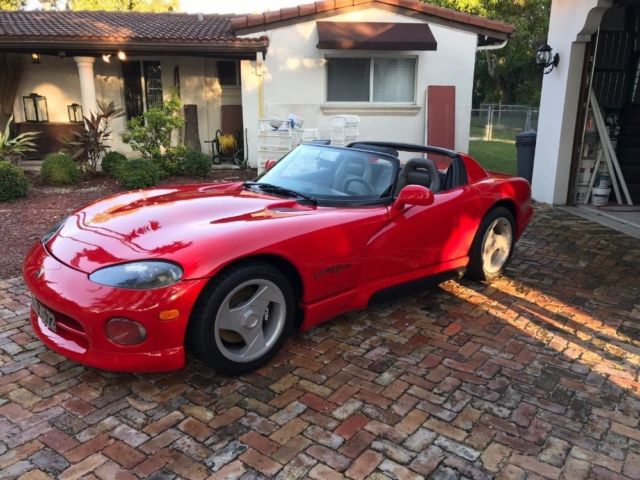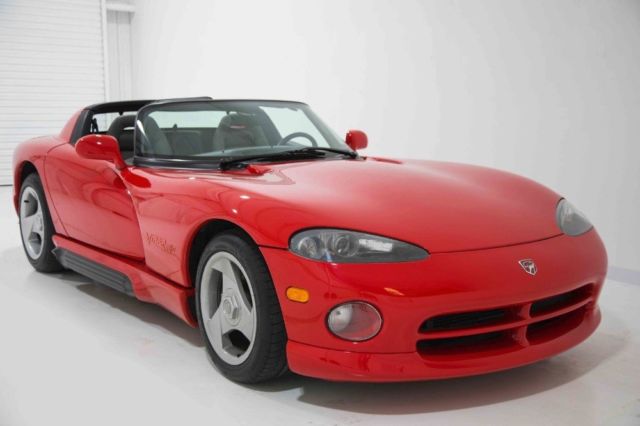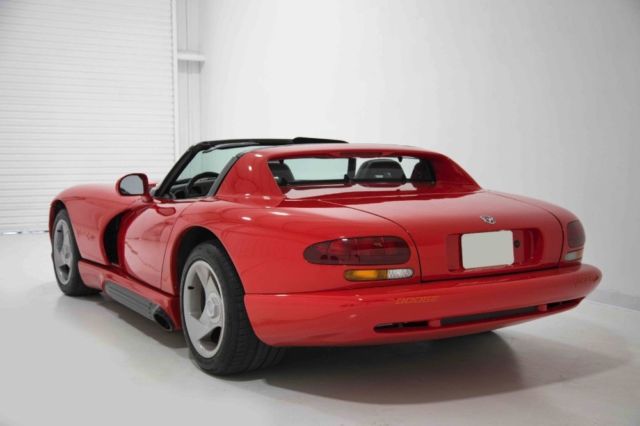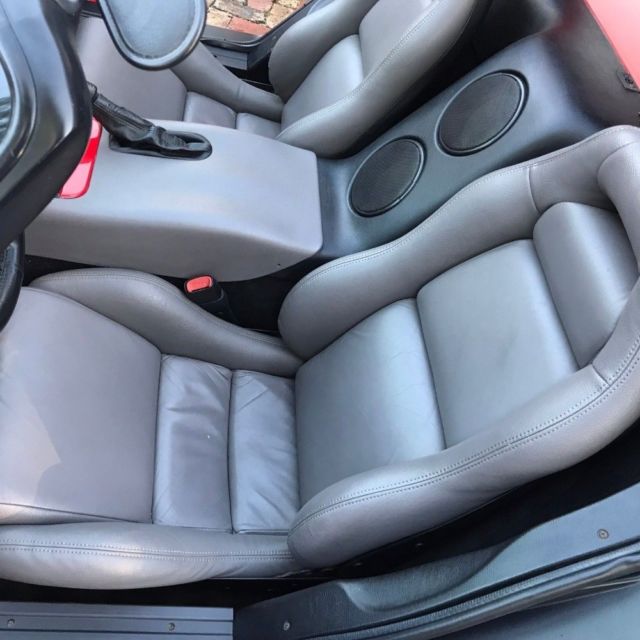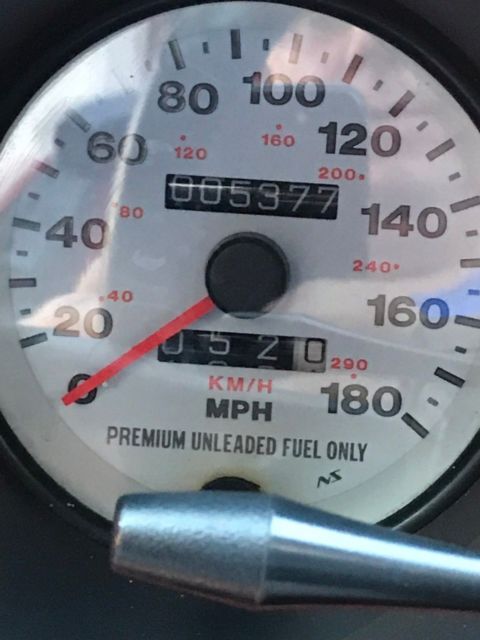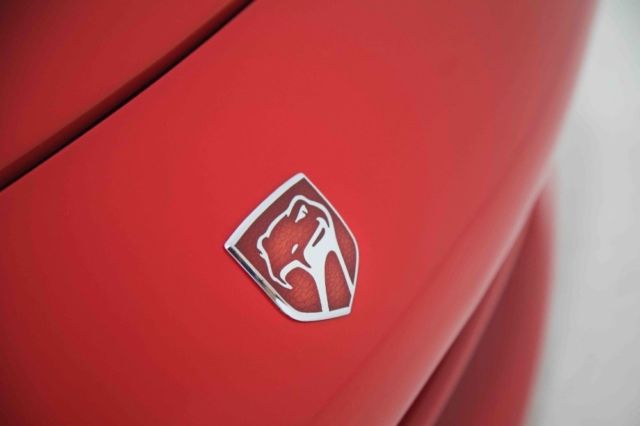1993 Dodge Viper for sale!
- Condition: Used
- Make: Dodge
- Model: Viper
- SubModel: -RT/10-EARLY PRODUCTION HAND ASSEMBLED-COLLECTORS
- Type: Roadster
- Trim: -RT/10-EARLY PRODUCTION HAND ASSEMBLED-COLLECTORS
- Year: 1993
- Mileage: 13,713
- VIN: 1B3BR65E6PV200790
- Color: Red
- Engine size: V10
- Power options: --
- Fuel: Gasoline
- Transmission: Manual
- Drive type: --
- Interior color: Gray
- Options: --
- Vehicle Title: Clear
- Location: Mundelein, Illinois, United States
Description
1993 Dodge Viper RT/10 has a six speed manual transmission and a 8 L V10 Motor boasting 400 HP. It runs great and drives even better. No defects on the vehicle. The car comes with the complete winter package (Side curtains, back window. and soft top). All items have a bag for their protection. The first year for Vipers were 1992 and that was limited production and also hand assembled along with the early production of 1993's as well.... Own a part of history at a great price- Vipers are not being built anymore-This is a collectors dream car.The first prototype was tested in January 1989. It debuted in 1991 with two pre-production models as the pace car for the Indianapolis 500 when Dodge was forced to substitute it in place of the Japanese-built Dodge Stealth because of complaints from the United Auto Workers, and went on sale in January 1992 as the RT/10 Roadster.The centerpiece of the car was its engine. Lamborghini, then owned by Chrysler Corporation, helped with the casting of the V10 out of aluminum alloy for the Viper, which was based on the Chrysler LA V8 engine. A major contributor to the Viper since the beginning was Dick Winkles, the chief power engineer, who had spent time in Italy.The engine weighs 711 lb (323 kg) and produces 400 bhp (300 kW) at 4,600 rpm and 465 lb⋅ft (630 N⋅m) at 3,600 rpm, and thanks to the long-gearing allowed by the engine, provides fuel economy at a United States Environmental Protection Agency-rated 12 mpg‑US (20 L/100 km; 14 mpg‑imp) city and 20 mpg‑US (12 L/100 km; 24 mpg‑imp) highway.[6] The body is a tubular steel frame with resin transfer molding (RTM) fiberglass panels. It has a curb weight of 3,284 lb (1,490 kg) and lacks modern driver aids such as traction control and anti-lock brakes. It completes a quarter mile (402 m) in 12.6 seconds at the speed of 113.8 mph (183.1 km/h) and has a maximum speed of approximately 165 mph (266 km/h).[7] Its large tires allow the car to average close to one lateral g in corners, placing it among the elite cars of its day. However, the car proves tricky to drive at high speeds, particularly for the unskilled drivers.The Viper was engineered to be a performance car, with no exterior-mounted door handles or key cylinders (entry was done by unzipping a soft vinyl window to reach the interior in order to pull the interior door release handle), and no air conditioning (however, this was added as an option in later models, and climate controls featured a "snowflake" icon, which indicated a potential setting for the A/C). The roof was made from canvas, and the windows were made from vinyl and used zippers to open and close, much like the Jeep Wrangler (YJ). However, the Viper was still equipped with some features in order to allow it to be tolerable as a daily driver. Some of these features included manually-adjustable sport leather-trimmed bucket seats with lumbar support, an A/M-F/M stereo cassette player with clock and high-fidelity sound system, and interior carpeting. Aluminum-alloy wheels were larger in diameter due to the larger brakes. A lightweight fiberglass hard roof option on later models was also available to cover the canvas soft roof, and shipped with each new car. There were also no airbags, in the interest of weight reduction. Adjustable performance suspension was also an available option for most Vipers. Car is located at our dealership for your viewing.WE FINANCE/DELIVER
 Dodge Viper Very Viper Red with 5,780 Miles, for sale!
Dodge Viper Very Viper Red with 5,780 Miles, for sale!
Mileage: 5,780
 1993 Dodge Viper Sports Car 26,751 Miles Viper Red 10 Cylinder Engine 8.0L/488
1993 Dodge Viper Sports Car 26,751 Miles Viper Red 10 Cylinder Engine 8.0L/488
Mileage: 26,751
 1993 Dodge Viper, Very Viper Red with 7K Miles, One Owner, Super Clean
1993 Dodge Viper, Very Viper Red with 7K Miles, One Owner, Super Clean
Mileage: 7,450
 1993 Dodge Viper Sports Car 3,779 Miles Viper Red 10 Cylinder Engine 8.0L/488 6
1993 Dodge Viper Sports Car 3,779 Miles Viper Red 10 Cylinder Engine 8.0L/488 6
Mileage: 3,779
 1993 Dodge Viper, Very Viper Red with 7K Miles, One Owner, Rare Antenna Car
1993 Dodge Viper, Very Viper Red with 7K Miles, One Owner, Rare Antenna Car
Mileage: 7,450
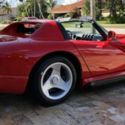 1993 Dodge Viper (antenna Viper)
1993 Dodge Viper (antenna Viper)
Mileage: 12970
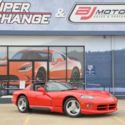 1994 Dodge Viper for sale!
1994 Dodge Viper for sale!
Mileage: 1,057
 DODGE VIPER - NO RESERVE SALE!
DODGE VIPER - NO RESERVE SALE!
Mileage: 47,215
 Dodge Viper Red with 5,400 Miles, for sale!
Dodge Viper Red with 5,400 Miles, for sale!
Mileage: 5400
 1992 Dodge Viper On MSO 710 Miles for sale!
1992 Dodge Viper On MSO 710 Miles for sale!
Mileage: 710
